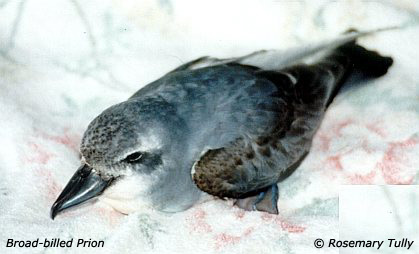Broad-billed Prion (Pachyptila vittata) - Wiki Broad-billed Prion
From Wikipedia, the free encyclopedia
Order: Procellariiformes
Family: Procellariidae
[Photo] Broad-billed Prion (Pachyptila vittata). Taken by Rosemary Tully of the Whakatane Bird Rescue Centre, New Zealand (www.nzbirds.com/more/rescue.html).
| Permission is granted to copy, distribute and/or modify this document under the terms of the GNU Free Documentation License, Version 1.2 or any later version published by the Free Software Foundation; with no Invariant Sections, no Front-Cover Texts, and no Back-Cover Texts. A copy of the license is included in the section entitled "GNU Free Documentation License". |
The Broad-billed Prion, Pachyptila vittata, is a small seabird with grey upperparts plumage, a dark cap,a black "W" on the wings, a black tail tip, and white underparts. This is a large prion, 25???30 cm long, with a wingspan of 57???66 cm and weighing in average 160???235 grams. It has a broad flat bill with comb-like fringes called lamellae. The head pattern is more distinct and the tail band is less extensive than that of the similar Fairy Prion.
This species is found throughout oceans and coastal areas in the Southern Hemisphere. Its colonies can be found on Gough Island, Marion Island, and on the sub-Antarctic Antipodes Islands off the coast of New Zealand.
Its diet consists mainly of planktonic crustaceans, but, like other Antarctic prions, it uses its special bill to filter this food from the water. It feeds by running across the ocean surface with its bill open under water, moving its head from side to side and skimming for copepods and other small creatures, similar in principle to how baleen whales use their filter plates. The flight is heavier and slower than that of other prions. this species feeds in large flocks but does not follow ships.
Breeding begins on the coastal slopes of the breeding islands in July or August. The parents incubate the egg for 50 days, and then spend another 50 days raising the chick. The main predators are skuas, although on some islands, cats and rats have reduced this prion’s numbers drastically. Colonies disperse from December onwards, although some adults remain in the vicinity of the breeding islands and may visit their burrows in winter.
http://en.wikipedia.org/wiki/Broad-billed_Prion| The text in this page is based on the copyrighted Wikipedia article shown in above URL. It is used under the GNU Free Documentation License. You may redistribute it, verbatim or modified, providing that you comply with the terms of the GFDL. |
